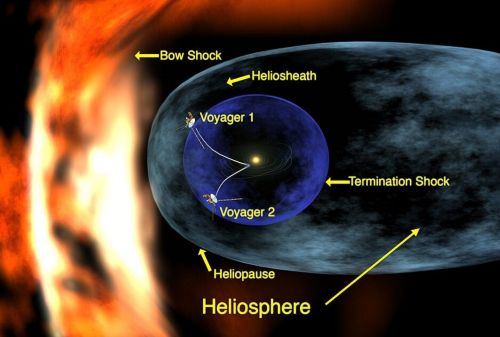

The image of a spacecraft, no larger than a car, whispering across the void from beyond the planets, stands as one of the most remarkable feats of human imagination.

By Matthew A. McIntosh
Public Historian
Brewminate
A Discovery at the Edge of the Known
Forty-seven years after its launch, Voyager 1 has delivered yet another astonishment. Scientists report that the spacecraft has encountered what they describe as a “wall of fire,” a boundary of superheated plasma measuring an estimated 90,000 degrees Fahrenheit. This discovery, located far beyond the orbit of Pluto, comes as the probe inches toward interstellar space.
For decades, Voyager has served as a messenger from the outer solar system. Each milestone has redefined human understanding of where the Sun’s influence ends and where the domain of the stars begins. The latest finding sharpens that frontier into something more visceral, less abstract: not a gradual fading, but a wall.
The Science Behind the Heat
The so-called “wall of fire” is not flame in the earthly sense. It is a plasma barrier formed where the solar wind collides with the interstellar medium. As charged particles from the Sun slow and pile up at this boundary, temperatures soar, creating a sheath of extreme heat around the heliosphere.
At roughly 90,000 degrees Fahrenheit, the plasma is far hotter than the surface of the Sun, though much thinner and less dense. This distinction matters. A human body would not ignite in such plasma, but the environment is deadly in a different way, hostile to any known form of life or unshielded technology. For Voyager, its aged but functional instruments continue to transmit data back across billions of miles, capturing faint signals that scientists painstakingly decode into evidence of this fiery frontier.
What the Boundary Means for Space Science
The heliopause, long theorized but rarely measured, marks the transition between solar and galactic domains. Voyager’s encounter with the wall of plasma demonstrates that this transition is more complex than anticipated. Instead of a neat line dividing the Sun’s reach from the interstellar sea, researchers are uncovering turbulent zones layered with energy and heat.
This insight carries implications for our broader understanding of cosmic weather. The boundary between solar and galactic winds is dynamic, shifting with cycles of solar activity. For spacecraft navigating these extremes, such forces pose challenges for communication, power, and longevity. More broadly, it reframes how scientists model the galaxy’s ability to shield or expose planets to cosmic radiation.
Cultural Resonance and Human Perspective
Voyager 1’s story is not only about data. It is also about perspective. Launched in 1977, the probe has outlived its designers, exceeded its mission parameters, and now whispers back tales from a realm once reserved for speculation. Its golden record, bearing sounds and images of Earth, was conceived as a time capsule for unknown intelligences. The discovery of a wall of fire gives that capsule an added poignancy. To cross into the interstellar medium is to step into a cosmic wilderness beyond the protective shield of our star.
For many, the phrase “wall of fire” evokes myth as much as science. Ancient traditions spoke of flames marking thresholds between worlds. Voyager’s transmission suggests that such imagery, while poetic, has unexpected echoes in the physics of plasma at the edge of space.
Skepticism and the Unknowns
Not all researchers agree on the interpretation. Some caution that the term “wall” risks exaggeration. Plasma environments are diffuse, and the notion of fire suggests solidity and danger in ways that may mislead. Others question whether Voyager’s aging instruments can fully capture the complexity of what it encounters. With only fragments of data available, extrapolation is both necessary and risky.
Still, skepticism does not diminish the weight of the finding. It emphasizes the provisional nature of science at the frontier. Just as early explorers misread coastlines or mapped continents with distorted proportions, so too do space scientists revise their understanding with every fragment Voyager sends.
Looking Beyond the Flames
As Voyager pushes further outward, its instruments will continue to test whether this wall of plasma is a stable boundary or a fluctuating sheath of energy. Each transmission is a reminder that exploration often delivers more questions than answers. The image of a spacecraft, no larger than a car, whispering across the void from beyond the planets, stands as one of the most remarkable feats of human imagination. That it now confronts a wall of fire at the edge of our solar system feels less like the end of a mission and more like the beginning of a new, uncharted story.
Originally published by Brewminate, 09.09.2025, under the terms of a Creative Commons Attribution-NonCommercial-NoDerivatives 4.0 International license.


